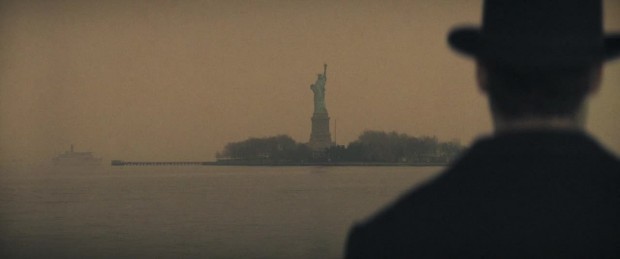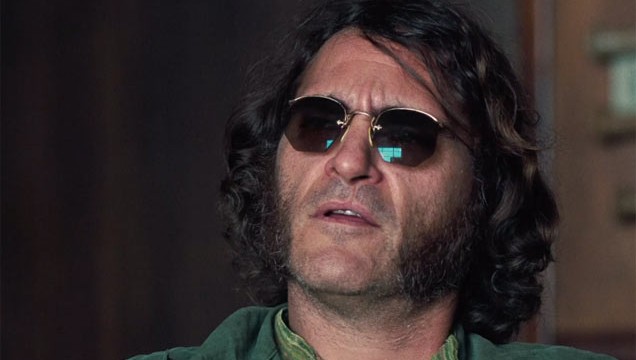This year gave us plenty of well-shot films. Here, The Narrator will take a look at the works he thought were the cream of the crop, the ones that best utilized the possibilities in filmmaking. Part 2 will cover even more of these films, and also Unbroken.

Peter Andrews, The Knick
I understand that it’s cheating to start a list of the year’s best-shot films with a TV series, but in a year where the primary adjective used to describe new series was “cinematic”, it feels necessary. And also I’m a fan of this Soderbergh person. As his first post-retirement project, The Knick shows a stylistically-recharged Soderbergh, using his previous tricks (blown-out whites, natural lighting) like never before (an early electricity-era hospital is the perfect place for Soderbergh and Co. to play with limited light sources). Soderbergh shot the series almost entirely handheld, and he’s liberated as a result, using the camera to explore every inch of the titular hospital. The blocking and framing is among the best Soderbergh has ever done, and even when the writing occasionally lagged, the direction and photography was never anything less than top-notch.

Favorite Sequence: Any sequence in “Get the Rope”, the series’s seventh and best episode, could be shown as a masterclass in filmmaking, but I’d have to go with the sequence where Algernon and his patients have to be snuck out of the hospital. That’s how you craft suspense, folks.

Emmanuel Lubezki, Birdman
If there was any film that equaled Soderbergh’s work on The Knick this year, it was this one. Even those who otherwise weren’t sold on the film couldn’t help but admit that Lubezki did a bang-up job here (for fuck’s sake, Mike D’Angelo thought he did a good job). If this isn’t Lubezki’s best-shot movie (that’s The Tree of Life), then it’s certainly his most Lubezkian movie, taking his pet themes from the previous decade (handheld, long takes, natural lighting) and taking them to their extremes, making a film that’s told entirely in one long, sometimes jittery, take, told in ordinarily-lit buildings. What could come off as a stunt instead perfectly captures the anxiousness of the cast leading up to the opening of their play. But even more than that, the long take serves as the best visual representation of theater in a long time. The camera plays the role of the excited theatergoer, excitedly touring the sets (in the film and in the play) and regarding the actors in awe as they Act. Sometimes, fancy camera tricks can get in the way of the actors, but here, they complement each other beautifully. And isn’t aiding the performances what cinematography is supposed to do (other than look pretty, of course?)?

Favorite Shot: Emma Stone has gotten lots of kudos for her big monologue directed at her character’s father here, and Lubezki wisely lets her, not the camera, do the speaking, the camera settling down a bit to observe her every complaint about her father. I also like the sequence where the camera does the thing where it moves a lot.


Darius Khondji, The Immigrant/Magic in the Moonlight
The word for both of Khondji’s films in 2014 is “lush”. In a year when the likely Oscar-winner went all into realism, Khondji wisely let realism fly out on the window for these projects. The Immigrant‘s obvious inspiration is the work of Gordon Willis, who similarly contrasted rich, golden hues with suffocating darkness, but Khondji goes even beyond Willis to create images of almost-overwhelming beauty, ones which tell a story through light and framing better than most movies can through scripts (the script is also really good too). And from Willis influence to shooting one of Woody Allen’s most gorgeous films since the Willis days. Magic in the Moonlight is a trifle, thin soup indeed, but lordy, it looks good. Khondji manages to outdo his similarly excellent work on Midnight in Paris with his picture-perfect images of the South of France, presenting it as eternally at magic-hour, shining rich, golden light onto its residents, who look even better here than they ever have on-screen (any shot of Emma Stone should be studied on how to light the human face for maximum beauty). If France’s tourism rate didn’t go up amongst the people who saw Moonlight, I will be surprised.

Favorite Shot: This isn’t only my favorite shot from both of these movies, it’s my favorite shot of any movie released this year.

Bruno Delbonnel, Big Eyes
Given that it’s largely been forgotten not even a month after its release, I can’t say I’m too surprised by the lack of recognition for Delbonnel’s work on Tim Burton’s latest, but I can definitely say that I’m disappointed. After running his gothic style into the ground for the last few years, Burton has wisely taken a step back with this movie, and made something gorgeously colorful. Delbonnel was last seen by most giving a wintry beauty to Inside Llewyn Davis, but you’d never guess it was shot by the same guy if you didn’t know. Perhaps inspired by the kitschy painting at the movie’s core, Delbonnel and Burton delight in creating a world of hues so bright and perfect that there’s no way they could sustain themselves in the real world (the blue of the sky seen in the film’s first minute gives this away), and why should they? The story at the heart of the film is about fakery, and who says the filmmakers can indulge in purposeful fakery (like the backgrounds which are either intricate-but-transparently-fake matte paintings or CGI replications of them) themselves?
Favorite Shot: I couldn’t find a screenshot of it online, but the shot of Margaret Keane, Walter Keane, and Margaret’s daughter walking to their apartment under an impossibly blue sky directly replicates one of Walter’s “street scene” paintings seen earlier, and I loved it.


Robert Elswit, Nightcrawler/Inherent Vice
Elswit has long been the best cinematographer for shooting California in the business, and in 2014, he proved that with two radically different-shot looks at the Golden State. Nightcrawler‘s look is that of a sleeker model of Michael Mann’s Collateral, using digital cameras to pierce into the L.A. darkness and find truly despicable things occurring there. Elswit is very much pro-film, but his work here suggests the work of someone who’s been utilizing digital for years, not a complete novice. But Elswit can still do fantastic things with film, as his other film, Inherent Vice, proves. If Nightcrawler was an L.A. nightmare in clear focus, Vice is a half-remembered dream of California, lost in a swarm of grain and soft light. Elswit and P.T. Anderson took inspiration from Vilmos Zsigmond’s work on Robert Altman’s The Long Goodbye (a similarly fuzzily beautiful film), and the end result is something which looks like the last great film of the 1970s.

Favorite Shot: One of Vice‘s most memorable sequences comes from a conversation between Doc Sportello and Coy Harlingen, throwing the film’s shaggy brand of paranoia into focus with a slow camera push-in and some moody lighting.

